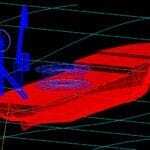[Posted on December 4th, 2013 by Bill Stewart]
Single point moorings are loading buoys anchored offshore, serving as an interconnection for tankers load and offload liquid or gaseous products. The buoy contains a bearing system that allows part of it to rotate around the moored geostatic part. A vessel can be able to weathervane around a buoy’s geostatic part when it is moored to it. A moored vessel can then rotate itself into a dominant environment, with the system minimizing loads on a buoy’s mooring system. This system can also be used when a vessel that one would like to moor is approaching the buoy.
Some of the single point moorings buoys are off the shelf products that offer various standard features, while others are custom designed. A mooring system, which consists of lines as well as anchor points, is designed to meet the requirements of a vessel and the local environment. Mooring systems are combined with fluid transfer systems, enabling the connection of subsea pipelines to a tanker. Fluid transfer systems include submarine hoses that are between the Pipeline End Manifold (PLEM) on a seabed and a buoy as well as the hoses that are between a buoy and a tanker.
Fabrication can be provided for single point moorings, including procurement, technology, construction, and logistics. Steel fabrication capacity is required if a company is to sustain the needs of a client who wants to develop oil and natural gas fields in increasingly remote geographic locations. To ensure that a client can achieve production at sustainable costs, steel fabrication facilities have to be able to meet the increasing demand for mooring systems. In addition, the technology and fabrication has to be done in a proper manner. The design and workmanship of the systems should also meet stringent rules that are in force.
Some of the offers available for single point moorings include the fabrication of the buoy body. Components for the mooring and anchoring can also be provided. A customer can also be provided with a product transfer system, such as the ones used for loading or offloading gas or liquid products. Auxiliary components can also be provided, including boat landing, handling, and lifting equipment. Navigation aids and power provisions can also be provided. Once the system has been set up, it could be an independent facility or an integrated system as part of an offshore platform.
Hydrodynamic analysis provides a critical insight into the behavior of water and other liquids, which affects water-borne vessels and related facilities, as well as containers that must manage liquid holding as well as liquid flow. Such an analysis provides key inputs into the designs of water locks or how the engines of a vessel perform with the turbines while producing a boat’s momentum. For a client who is considering a major project such as dredging, vessel production, harbor design, or a new water channel, this analysis plays a vital role in decision making and resource allocation.



